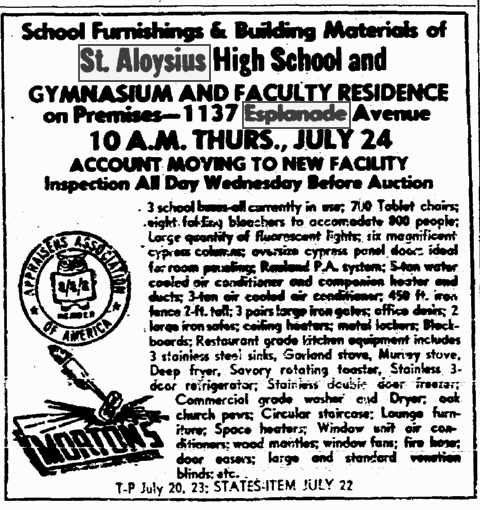|
Today in New Orleans History |
|
|
July 23


 To receive an update for each day in New Orleans history,
join our facebook page - Today in New
Orleans History.
A Coast Guard crewman observes the sunken barge surrounded by tugs in the Mississippi River. (U.S.
Coast Guard Photo) The 2008 New Orleans oil spill was an oil spill that occurred on July 23,2008
at New Orleans, Louisiana, in which No. 6 fuel oil was spilled into the Mississippi River after a tanker collided with Barge
DM932 being pulled by a tugboat upriver near the Crescent City Connection. Although early estimates stated approximately 400,000
gallons (1,514,164 liters) of the fuel oil was spilled into the river, subsequent estimates by the Office of Response and
Restoration of the National Ocean Service placed the spill at approximately 280,000 gallons At about
1:30 a.m. local time on July 23, 2008, the Tintomara, a 600 Liberian-flagged tanker collided with the 61 ft barge carrying
No. 6 fuel oil being towed by the tug Mel Oliver operated by DRD Towing of Harvey. The barge was picked up from the John W.
Stone Oil Distributor in Gretna. By July 24, the Coast Guard closed the river to all ships from mile
marker 97 in New Orleans to the Southwest Pass estuary at the Gulf of Mexico. By midday, the slick had reached as far as Venice,
with only 140 barrels (22 m3) of oil contained and removed from the river. Floating, containment booms were utilized
in the cleanup with many being placed in strategic locations in order to minimize the impacts of the Delta National Wildlife
Refuge. With clean-up well underway, the barge released an estimated 2,500 gallons of oil into the river
on July 30, resulting in its closure to river traffic for a period of six hours. The pumping of the remaining fuel oil would
commence shortly thereafter, with the actual removal of the damaged barge underway during the week of August 4, 2008 The closure resulted a halting of river traffic with many ships being held in New Orleans. The closure resulted
in the Port of New Orleans losing an estimated $100,000 in revenue for each day it remained closed. Also, Carnival Cruise
Lines diverted its lead Fantasy class ship Carnival Fantasy to Mobile, Alabama through the September 1, 2008 cruise before
going to its scheduled four week drydock. It returned to New Orleans on October 4, 2008. (Wiki)  To receive an update for each day in New Orleans
history, join our facebook page
- Today in New Orleans History
Photo -- NORD Travelling Theater at Coliseum Playground, July 23, 1947. The performance may have been a one-act play called The Telegram (author unknown), which
NORD produced that summer. The original NORD Traveling Theater, which debuted in 1947, was built on the chassis of an old
garbage wagon (the kind pulled by mules!) and featured a complete 12’ x 16’ stage, curtain, interior sets, and
a public address system. The theater, with casts made up of playground children, visited playgrounds and NORD centers around
the city. In 1949, the city turned over a converted bus for use as the theater. (NOPL)
Several photos -- Art class conducted by WPA instructors for children at the Gentilly Terrace School. Click here for the names of the children and teacher in the photographs, July 23, 1940. (NOPL) Several photos - Achievement Day at Statewide Bookbinding Project, located at Carondelet Streetand Jackson Avenue, July 23, 1938.
BREAUX, Joseph Arsène, attorney, educator, businessman, jurist. Born, Bayou Goula, Iberville
Parish, La., February 18, 1838; son of Margaret Walsh and John B. Breaux. Education: attended local private schools;
Georgetown College, Kentucky, B. A.; University of Louisiana, law degree, 1859. Admitted to the bar and practiced law
in Iberville Parish, 1859; published newspaper, The Weeky Magnolia, Plaquemine, 1861. Married, 1861, Eugenia Mille,
daughter of Thomas Mille, planter of Iberville Parish. No children. Enlisted in the Confederate Army, September
24, 1862; captain, Thirtieth Louisiana Infantry, 1862; private and orderly sergeant, Second Louisiana Cavalry, 1862-1864;
lieutenant and adjutant, Eighth Louisiana Cavalry, 1864-1865. Practiced law in Lafayette, 1865; superintended the distribution
of food during yellow fever epidemic, 1867; removed to Abbeville, in 1868 removed to New Iberia; formed law partnership with
William F. Schwing, 1875. Associated with the P. L. Renoudet Lumber Company of New Iberia in 1879; a founder and first
president, New Iberia National Bank; member, and later superintendent, of the Iberia Parish School Board, 1880-1888.
Elected state superintendent of public education, 1888; compiled school laws of state and court decisions relating to those
laws; compilation published in 1889. Appointed associate justice of state supreme court, April 24, 1890, and chief
justice, 1904; served as chief justice until retirement, 1914. Donated a large sum of money to Charity Hospital, New Orleans;
administration building bears his name. Member of the board of Tulane University and Louisiana State Museum; member,
Loyola Law School faculty, Louisiana Historical Society and United Confederate Veterans Camp No. 9. Catholic. Died,
New Orleans, July 23, 1926; interred Metairie Cemetery. A.W.B. & J.B.C. Sources: Report
of the Louisiana Bar Association for 1927 and 1928, XXVIII (September, 1928); Who's Who in America, IX, (1916-1917); New Orleans
Times-Picayune, obituary, July 24, 1926; Walter Prichard, ed., "A Tourist's Description of Louisiana in 1860," Louisiana
Historical Quarterly, XXI (1938); Hubert Humphreys, "In a Sense Experimental: The Civilian Conservation Corps in
Louisiana," Louisiana History, VI (1965). From http://lahistory.org/site19.php
On July 23, 1861, Confederate General Joseph E. Johnston recommended to President
Jefferson Davis that P.G.T. Beauregard be promoted to full general. Davis approved.
Bernardo de Gálvez y Madrid, Viscount of Galveston and Count of Gálvez (Macharaviaya, Málaga,
Spain July 23, 1746 – November 30, 1786) was a Spanish military leader and colonial administrator who
served as colonial governor of Louisiana and Cuba, and later as Viceroy of New Spain. (Wiki) |
|
|

To receive an update for each day in New Orleans history,
join our facebook page - Today in New
Orleans History.
Analytics |



